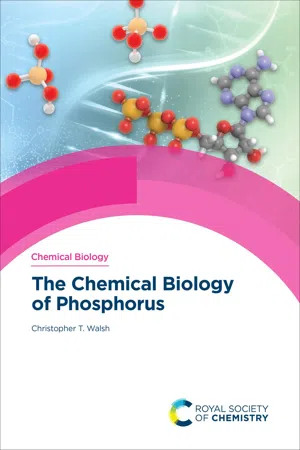Chemistry
Phosphate Group
A phosphate group is a chemical unit consisting of a phosphorus atom bonded to four oxygen atoms. It is a key component of molecules such as ATP, DNA, and RNA, where it plays a crucial role in energy transfer and storage, as well as in genetic information transmission and processing. The presence and arrangement of phosphate groups greatly influence the properties and functions of these molecules.
Written by Perlego with AI-assistance
Related key terms
Related key terms
1 of 4
Related key terms
1 of 3
3 Key excerpts on "Phosphate Group"
- eBook - ePub
Essentials of Inorganic Chemistry
For Students of Pharmacy, Pharmaceutical Sciences and Medicinal Chemistry
- Katja A. Strohfeldt(Author)
- 2015(Publication Date)
- Wiley(Publisher)
Phosphorus (P) is a nonmetal of the nitrogen group. As previously outlined, +3 and +5 are the preferred oxidation states, forming a variety of allotropes, with black phosphorus being the most stable one. Phosphorus is one of the most abundant elements in the human body and is often found in conjunction with calcium, because together they are the building materials for bones and teeth. Phosphorus is also involved in the building of our genetic material as well as in the energy supply of cells and many biochemical processes.Within the human body, phosphate is the main phosphorus-containing compound. Phosphate is an inorganic compound and is the salt of phosphoric acid. It can form organic esters with a variety of compounds and these are important in many biochemical processes. Phosphate has the empirical formula PO4 3− . It is a tetrahedral molecule, where the central phosphorus atom is surrounded by four oxygen atoms (Figure 6.5 ).Chemical structure of phosphateFigure 6.5The phosphate ion PO4 3− is the conjugated base of the hydrogen phosphate ion (HPO4 2− ). HPO4 2− is the conjugated base of the dihydrogen phosphate ion (H2 PO4 − ). The latter is the conjugated base of phosphoric acid (H3 PO4 ).A conjugated base is formed from an acid by the removal of a proton. This means that the conjugate base of an acid is this acid without a proton. An analogous definition applies to a conjugate acid.In biological systems, phosphate is often found either as the free ion (inorganic phosphate) or as an ester after reaction with organic compounds (often referred to asorganic phosphates). Inorganic phosphate (mostly denoted as Pi ) is a mixture of HPO4 2− and H2 PO4 − at physiological pH.6.2.1 Adenosine phosphates: ATP, ADP and AMP
Adenosine phosphates are organic-phosphate-containing compounds that are responsible for the energy flow in many biochemical processes in living cells. Adenosine phosphates consist of three parts: a sugar molecule (ribose) as the backbone, to which a nucleobase adenine and a varying number of Phosphate Groups are connected. Adenine is bonded to C-1 of the sugar, whilst the Phosphate Groups are connected to each other and then are attached to the C-5 atom of the ribose backbone. There is a series of adenosine phosphates depending on the number of Phosphate Groups present. Adenosine triphosphate (ATP) contains three Phosphate Groups, whilst adenosine diphosphate (ADP) contains two and adenosine monophosphate (AMP) contains one Phosphate Group (Figure 6.6 - eBook - ePub
- Christopher T Walsh(Author)
- 2020(Publication Date)
- Royal Society of Chemistry(Publisher)
6 analyze Todd's arguments and provide additional perspective 30 years on. Among the properties embedded in phosphate chemistry essential to biology are the following:- DNA information retention from organism generation to generation requires ultrastable phosphodiester internucleotide bonds, that are nonetheless rapidly repairable when necessary.
- If life started via an RNA world then phosphodiesters were key covalent linkages stitching together bits of chemical information.
- Lipid membrane barriers define an inside and outside for cells and organisms and allow establishment of transmembrane electrochemical potentials. Phospholipid diester head groups , attached covalently to lipid tails, are the universal building blocks for biological membranes.
- To build skeletons strong enough to support large organisms, most notably mammals, calcium phosphate salts comprise the building block for bones and teeth
- Organisms constantly need energy supplies to survive. The energetics of life are built around phosphoric anhydride chemistry
- Regulation of information flow and signaling over different time regimes is dominated by two parallel signaling regimes involving phosphate chemistry : (a) a set of low molecular weight second messengers: cyclic adenosine monophosphate (cAMP), cyclic guanosine monophosphate (cGMP), di-cyclic GMP, di-cyclic GMP–cAMP; (b) protein posttranslational phosphorylations.
We take up each of these facets of Phosphate Group chemistry in biological contexts through the subsequent chapters of this book. Life is certainly more than phosphoryl group chemistry but no other element in the periodic table exhibits chemical properties that would allow life to be constructed by a phosphorus replacement. (Pentavalent arsenic has some replacement properties, but its esters are chemically labile in aqueous physiological media). - eBook - ePub
Organophosphorus Chemistry
From Molecules to Applications
- Viktor Iaroshenko(Author)
- 2019(Publication Date)
- Wiley-VCH(Publisher)
Thus, Wald attributed the biological selection of P to the facts that (i) it forms more open and generally weaker bonds than its congeners in the second period of the periodic table, O and N, (ii) it possesses 3d orbitals, allowing for the expansion of its valences beyond four, and (iii) it is capable of forming multiple bonds, which is also characteristic of the elements C, N, and O [7]. Importantly, this ability to form multiple bonds is essential to the thermodynamics of energy transfer. In his classic discussion of “why Nature chose phosphates,” Westheimer [8] explored chemical rationales underlying the myriad roles that phosphorus‐containing molecules play in living organisms [9]. The ability of phosphoric acid to link two nucleotides via phosphoester bonds, while still maintaining its ionized state, was identified as essential to stabilize the P–O–P esters against spontaneous hydrolysis (the hydrolysis of the phosphodiester bonds in the DNA backbone has a t 1/2 of 130 000 years in neutral solution at room temperature) [10]. Some of the most important roles of biophosphorus compounds – cellular energy storage and transfer, cell signaling, molecular media for genetic information storage and transmission, formation of lipid bilayers in membranes – are exemplified by the well‐known structures shown in Figure 10.1, not to mention calcium phosphate, the key mineral constituent of bone. This unique versatility of phosphorus in both functional and structural biology has led to the evolution of a vast array of biophosphate compounds exhibiting a plethora of activities within a cell
Index pages curate the most relevant extracts from our library of academic textbooks. They’ve been created using an in-house natural language model (NLM), each adding context and meaning to key research topics.
Explore more topic indexes
Explore more topic indexes
1 of 6
Explore more topic indexes
1 of 4


